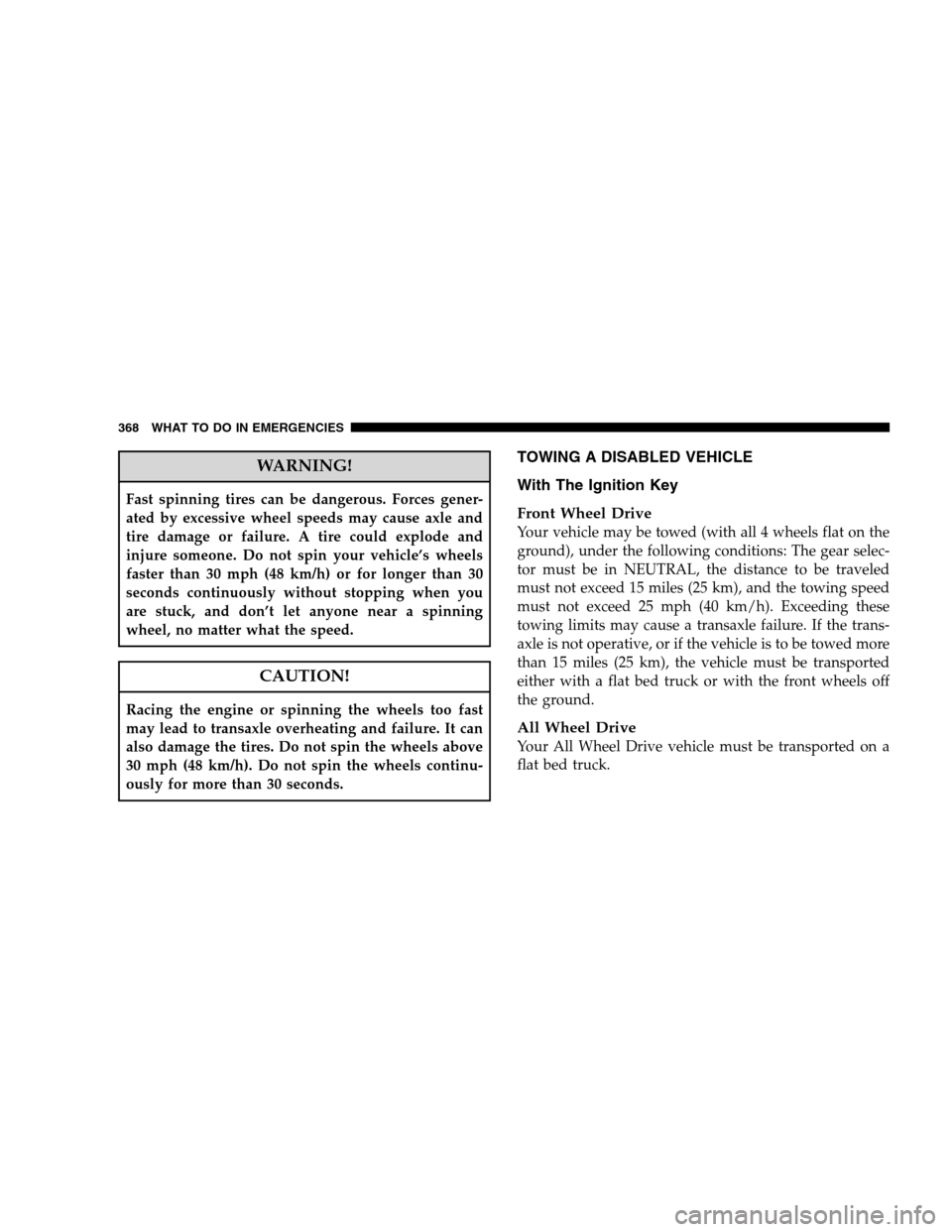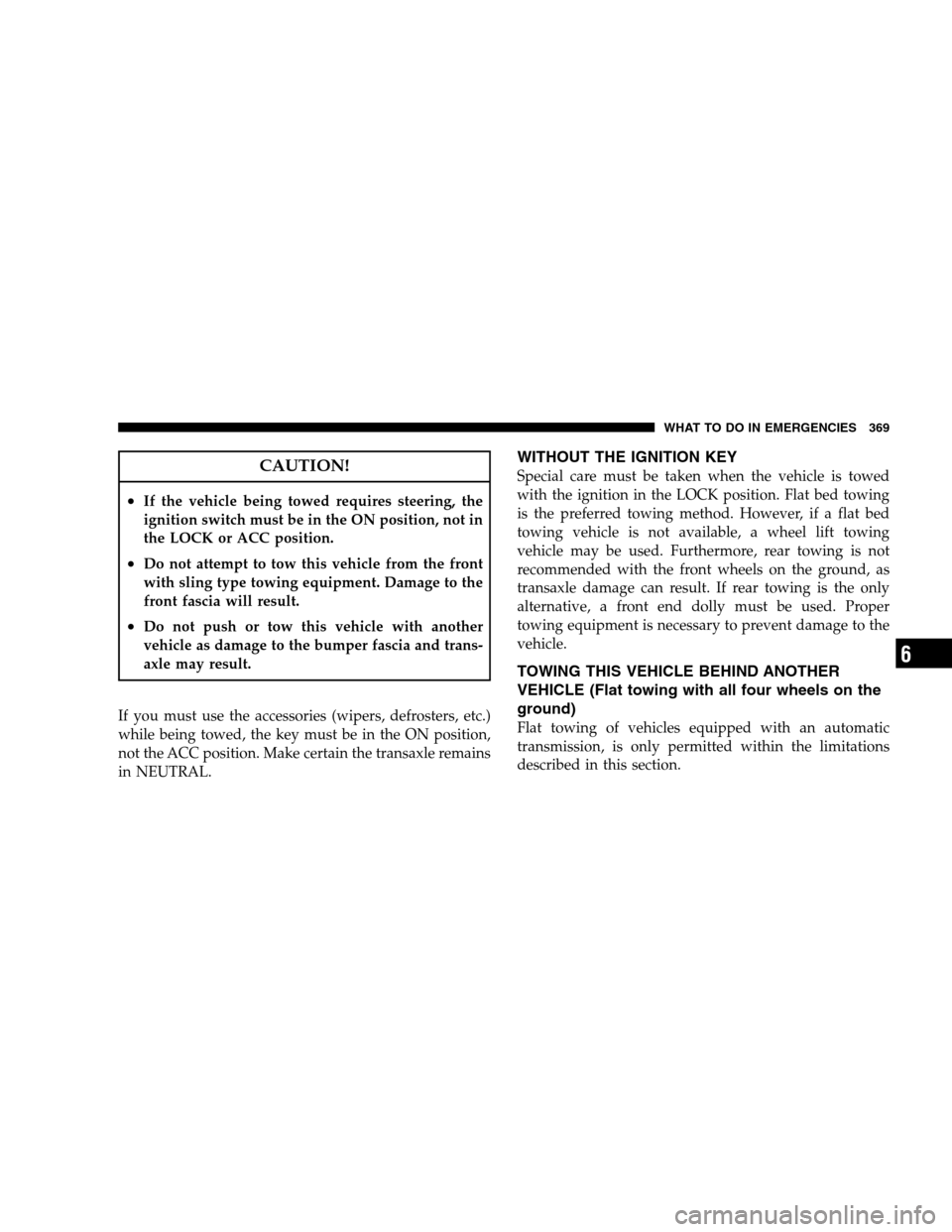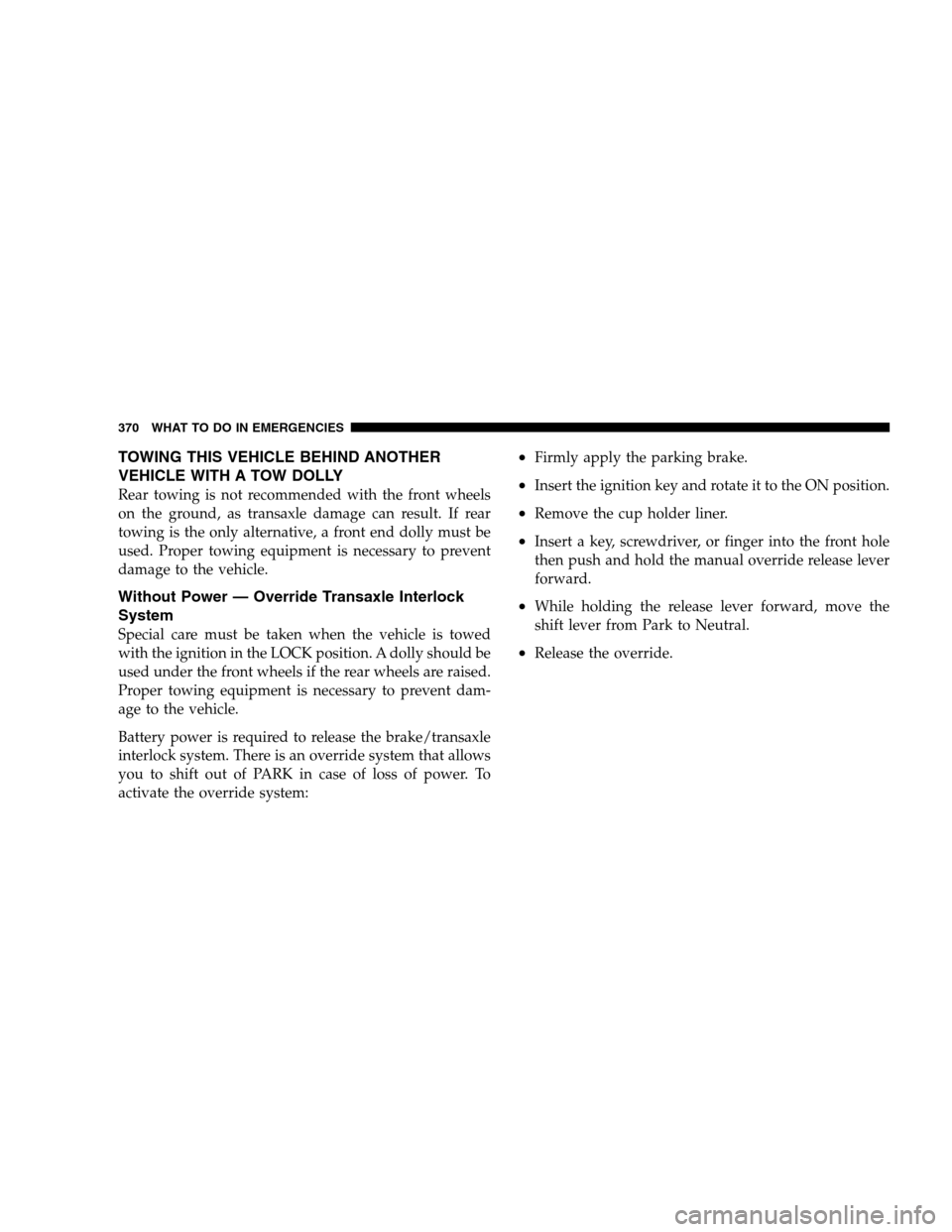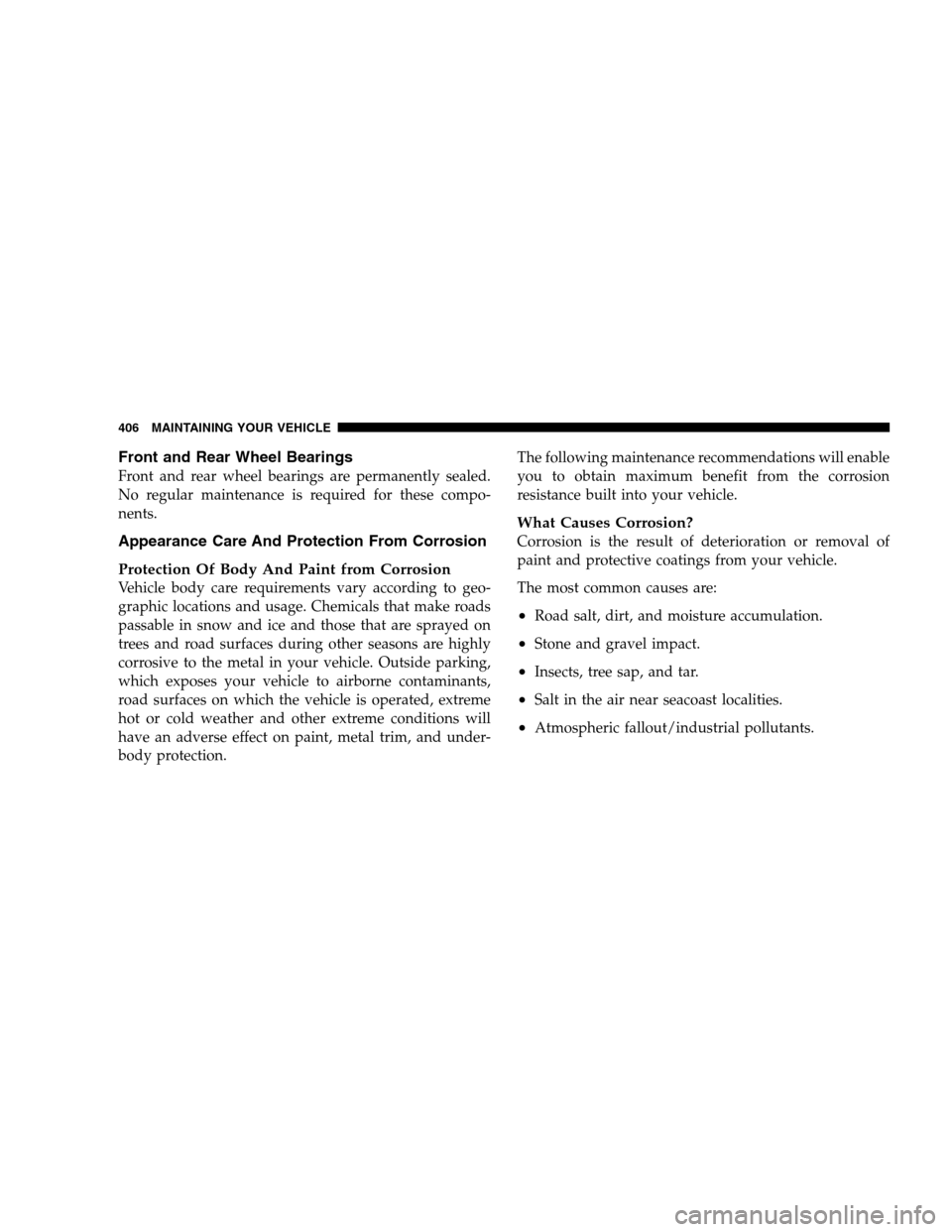Page 366 of 494

JUMP-STARTING PROCEDURES DUE TO A LOW
BATTERY
Jump-starting remote battery terminals are located under
the hood.
The battery is stored between the left front headlight
assembly and the left front wheel splash shield. Access is
through the splash shield.
WARNING!
•Take care to avoid the radiator cooling fan when-
ever the hood is raised. It can start anytime the
ignition switch is on. You can be hurt by the fan.
•Do not attempt to push or tow your vehicle to get
it started. Vehicles equipped with an automatic
transaxle cannot be started this way. Unburned
fuel could enter the catalytic converter and once
the engine has started, ignite and damage the
converter and vehicle. If the vehicle has a dis-
charged battery, booster cables may be used to
obtain a start from another vehicle. This type of
start can be dangerous if done improperly, so
follow this procedure carefully.
•Do not use a booster battery or any other booster
source with an output that exceeds 12 volts.
364 WHAT TO DO IN EMERGENCIES
Page 369 of 494

NOTE:Refer to “Maintenance Procedures” in Section 7
of this manual for information on accessing the battery
for service or replacement.
WARNING!
Any procedure other than above could result in:
1. Personal injury caused by electrolyte squirting out
the battery vent;
2. Personal injury or property damage due to battery
explosion;
3. Damage to charging system of booster vehicle or
of immobilized vehicle.
FREEING A STUCK VEHICLE
If your vehicle becomes stuck in mud, sand, or snow, it
can often be moved by a rocking motion. Turn your
steering wheel right and left to clear the area around the
front wheels. Then shift back and forth between Reverse
and First gear. Usually the least accelerator pedal pres-
sure to maintain the rocking motion without spinning the
wheels is most effective.
NOTE:
If your vehicle is equipped with Traction Con-
trol, turn the system to Partial OFF before
attempting to “rock” the vehicle. Refer to “Par-
tial Off Mode” under “Electronic Stability Pro-
gram (ESP)” in Section 5 of this manual.
WHAT TO DO IN EMERGENCIES 367
6
Page 370 of 494

WARNING!
Fast spinning tires can be dangerous. Forces gener-
ated by excessive wheel speeds may cause axle and
tire damage or failure. A tire could explode and
injure someone. Do not spin your vehicle’s wheels
faster than 30 mph (48 km/h) or for longer than 30
seconds continuously without stopping when you
are stuck, and don’t let anyone near a spinning
wheel, no matter what the speed.
CAUTION!
Racing the engine or spinning the wheels too fast
may lead to transaxle overheating and failure. It can
also damage the tires. Do not spin the wheels above
30 mph (48 km/h). Do not spin the wheels continu-
ously for more than 30 seconds.
TOWING A DISABLED VEHICLE
With The Ignition Key
Front Wheel Drive
Your vehicle may be towed (with all 4 wheels flat on the
ground), under the following conditions: The gear selec-
tor must be in NEUTRAL, the distance to be traveled
must not exceed 15 miles (25 km), and the towing speed
must not exceed 25 mph (40 km/h). Exceeding these
towing limits may cause a transaxle failure. If the trans-
axle is not operative, or if the vehicle is to be towed more
than 15 miles (25 km), the vehicle must be transported
either with a flat bed truck or with the front wheels off
the ground.
All Wheel Drive
Your All Wheel Drive vehicle must be transported on a
flat bed truck.
368 WHAT TO DO IN EMERGENCIES
Page 371 of 494

CAUTION!
•If the vehicle being towed requires steering, the
ignition switch must be in the ON position, not in
the LOCK or ACC position.
•Do not attempt to tow this vehicle from the front
with sling type towing equipment. Damage to the
front fascia will result.
•Do not push or tow this vehicle with another
vehicle as damage to the bumper fascia and trans-
axle may result.
If you must use the accessories (wipers, defrosters, etc.)
while being towed, the key must be in the ON position,
not the ACC position. Make certain the transaxle remains
in NEUTRAL.
WITHOUT THE IGNITION KEY
Special care must be taken when the vehicle is towed
with the ignition in the LOCK position. Flat bed towing
is the preferred towing method. However, if a flat bed
towing vehicle is not available, a wheel lift towing
vehicle may be used. Furthermore, rear towing is not
recommended with the front wheels on the ground, as
transaxle damage can result. If rear towing is the only
alternative, a front end dolly must be used. Proper
towing equipment is necessary to prevent damage to the
vehicle.
TOWING THIS VEHICLE BEHIND ANOTHER
VEHICLE (Flat towing with all four wheels on the
ground)
Flat towing of vehicles equipped with an automatic
transmission, is only permitted within the limitations
described in this section.
WHAT TO DO IN EMERGENCIES 369
6
Page 372 of 494

TOWING THIS VEHICLE BEHIND ANOTHER
VEHICLE WITH A TOW DOLLY
Rear towing is not recommended with the front wheels
on the ground, as transaxle damage can result. If rear
towing is the only alternative, a front end dolly must be
used. Proper towing equipment is necessary to prevent
damage to the vehicle.
Without Power — Override Transaxle Interlock
System
Special care must be taken when the vehicle is towed
with the ignition in the LOCK position. A dolly should be
used under the front wheels if the rear wheels are raised.
Proper towing equipment is necessary to prevent dam-
age to the vehicle.
Battery power is required to release the brake/transaxle
interlock system. There is an override system that allows
you to shift out of PARK in case of loss of power. To
activate the override system:
•Firmly apply the parking brake.
•Insert the ignition key and rotate it to the ON position.
•Remove the cup holder liner.
•Insert a key, screwdriver, or finger into the front hole
then push and hold the manual override release lever
forward.
•While holding the release lever forward, move the
shift lever from Park to Neutral.
•Release the override.
370 WHAT TO DO IN EMERGENCIES
Page 374 of 494

▫A/C Air Filter — If Equipped............389
▫Power Steering — Fluid Check............391
▫Front Suspension Ball Joints..............391
▫Steering Linkage......................392
▫Body Lubrication.....................392
▫Windshield Wiper Blades................392
▫Windshield Washers...................393
▫Exhaust System......................393
▫Cooling System.......................394
▫Hoses And Vacuum/Vapor Harnesses.......400
▫Fuel System.........................400
▫Brake System........................400
▫Automatic Transaxle...................403▫Front And Rear Wheel Bearings...........406
▫Appearance Care And Protection From
Corrosion...........................406
▫Cleaning The Center Console Cup Holders . . . 411
�Fuses/Totally Integrated Power Module
(TIPM)..............................412
�Vehicle Storage........................417
�Replacement Bulbs......................417
�Bulb Replacement......................418
▫Headlight Bulb Replacement.............418
▫Head Light Assembly Removal —
Bulb Replacement.....................420
▫Front Turn Signal/Park Light.............422
▫FrontFogLight ......................422
372 MAINTAINING YOUR VEHICLE
Page 389 of 494

To minimize the possibility of catalyst damage:
•Do not shut off the engine or interrupt the ignition when
the transaxle is in gear and the vehicle is in motion.
•Do not try to start the engine by pushing or towing the
vehicle.
•Do not idle the engine with any ignition coil connec-
tors disconnected for prolonged periods.
Maintenance-Free Battery
You will never have to add water, nor is periodic main-
tenance required.
NOTE:The battery is stored in a compartment behind
the left front fender and is accessible without removing
the tire and wheel. Remote battery terminals are located
in the engine compartment for jump-starting.
To access the battery, turn the steering wheel fully to the
right and remove the inner fender shield.
WARNING!
•Battery fluid is a corrosive acid solution and can
burn or even blind you. Don’t allow battery fluid
to contact your eyes, skin, or clothing. Don’t lean
over a battery when attaching clamps. If acid
splashes in eyes or on skin, flush the area imme-
diately with large amounts of water.
•Battery gas is flammable and explosive. Keep
flame or sparks away from the battery. Don’t use a
booster battery or any other booster source with an
output greater than 12 volts. Don’t allow cable
clamps to touch each other.
•Battery posts, terminals, and related accessories
contain lead and lead compounds. Wash hands
after handling.
MAINTAINING YOUR VEHICLE 387
7
Page 408 of 494

Front and Rear Wheel Bearings
Front and rear wheel bearings are permanently sealed.
No regular maintenance is required for these compo-
nents.
Appearance Care And Protection From Corrosion
Protection Of Body And Paint from Corrosion
Vehicle body care requirements vary according to geo-
graphic locations and usage. Chemicals that make roads
passable in snow and ice and those that are sprayed on
trees and road surfaces during other seasons are highly
corrosive to the metal in your vehicle. Outside parking,
which exposes your vehicle to airborne contaminants,
road surfaces on which the vehicle is operated, extreme
hot or cold weather and other extreme conditions will
have an adverse effect on paint, metal trim, and under-
body protection.The following maintenance recommendations will enable
you to obtain maximum benefit from the corrosion
resistance built into your vehicle.
What Causes Corrosion?
Corrosion is the result of deterioration or removal of
paint and protective coatings from your vehicle.
The most common causes are:
•Road salt, dirt, and moisture accumulation.
•Stone and gravel impact.
•Insects, tree sap, and tar.
•Salt in the air near seacoast localities.
•Atmospheric fallout/industrial pollutants.
406 MAINTAINING YOUR VEHICLE